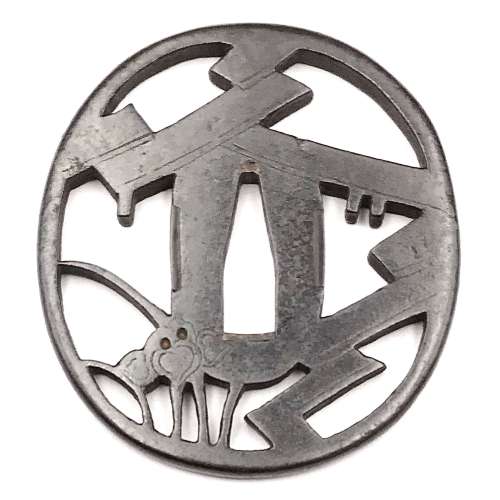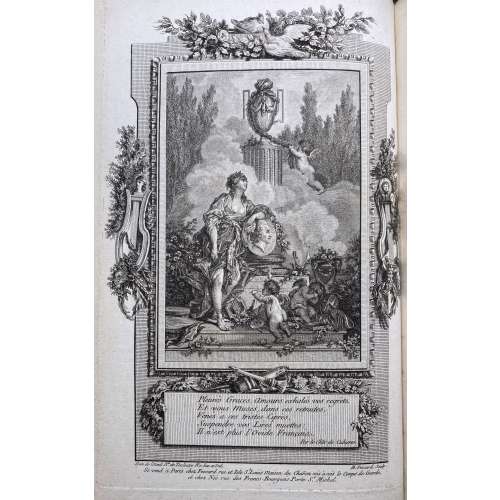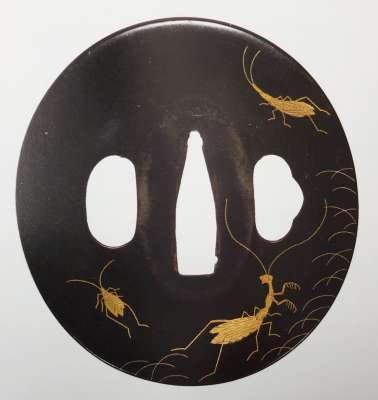Two-volume large paper edition with 20 plates in two states.
Vol. 1 (with plates).
Title : CONTES | ET | NOUVELLES EN VERS. | PAR | JEAN DE LA FONTAINE. | — | TOME PREMIER| {vignette “
P.P. Choffard 95”} | A PARIS, | DE L’IMPRIMERIE DE P. DIDOT L'AÎNÉ. | L’AN III DE LA RÉPUBLIQUE. | M. DCC. XCV. ||
Pagination: [2] [i-iv] v-vii [viii], 1-280 [2 table] [2], total 294 pages, ils.
Collation: 4to; 1 blank, π
4 (π
3a signed “a”), 1-35
4 36
1, 1 blank, total 147 leaves, plus 40 leaves of plates with tissue guards, after Fragonard and others, which represent 20 engravings, each in two states, before and after letters, besides №9 (
Le Calendrier des Vieillards by Jean Dambrun after Fragonard), which has two identical copies, both before letters.
Vol. 2. (without plates)
Title: same, but TOME SECOND.
Pagination: [2] [4] 1-334 [2], total 342 pages.
Collation: 4to; 1 blank, π
2 1-41
4 42
3 1 blank, total 167 leaves.
Binding: Two volumes uniformly bound in crimson straight-grain morocco, ruled in gilt, gilt-decorated flat spine with lettering, board edges and turn-ins tooled with gilt dentelles, marbled endpapers, three bookplates to front pastedown, top edge trimmed, 2
nd volume partly uncut; text and plates printed on thick Dutch wove paper.
Size: volumes: 33.3 x 25.2 cm; leaves: 31.5 x 23.5 cm.
Provenance:
Bishop, Cortlandt Field (American, 1870 – 1935) – bookplate.
Mary S. Collins – bookplate by J. H. Fincken.
Robin F. Satinsky (American, 1919 – 2008) – Robin Collection bookplate.
Catalogue raisonné: Ray (French): 133-137; Cohen-DeRicci 573-582 ; Lewine : 281-282.
CONTRIBUTORS:
Jean de La Fontaine (French, 1621–1695) – author.
Pierre Didot (French, 1761–1853) – publisher, printer.
Artists:
Jean-Honoré Fragonard (French, 1732–1806)
Jean Baptiste Mallet (French, 1759–1835)
Jacques Louis François Touzé (French, 1747–1807)
Charles Monnet (French, 1732–after 1808)
Engravers:
Jacques Aliamet (French, 1726–1788)
Jean Dambrun (French, 1741–about 1808)
Jean Louis Delignon (French, 1755–about 1804)
Jean Baptiste Michel Dupréel (French, active 1787–1817)
Louis Michel Halbou (French, 1730–1809)
Charles Louis Lingée (French, 1748–1819)
Charles Emmanuel Jean Baptiste Patas (French, 1744–1802)
Jean Baptiste Simonet (French, 1742–1813)
Jean Baptiste Tilliard (French, 1740–1823)
Philippe Trière (French, 1756–about 1815)
Pierre-Philippe Choffard (French, 1730–1809) – t.p. vignette
PLATES (collation order):
№8: Fragonard / Trière –
La Gageure des trois Commères
№1*: Fragonard / Lingée –
Joconde
№1**: Mallet / Trière –
Joconde
№2: Fragonard / Delignon –
Le Cocu battu et content
№3: Fragonard / Tilliard –
Le Mari confesseur
№4: Fragonard / Dambrun –
Le Savetier
№5: Fragonard / Lingée –
Le Paysan qui avait offensé son Seigneur
№9: Fragonard / Dambrun –
Le Calendrier des Vieillards
№10: Fragonard / Aliamet –
A Femme avare galant Escroc
№12: Fragonard / Halbou –
Le Gascon puni
№11: Fragonard / Patas –
On ne s’avise jamais de tout
№13: Monnet / Tilliard –
La Fiancée du roi de Garbe
№14: Fragonard / Dupréel –
La Coupe enchantée
№15: Fragonard / Tilliard –
Le Faucon
№17: Fragonard / Patas –
Le Pâté d’Anguilles
№18: Fragonard / Tilliard –
Le Magnifique
№19: Fragonard / Delignon –
La Matrone d’Ephèse
№20: Fragonard / Patas –
Belphégor
№22: Touzé / Simonet –
Le Glouton
№26: Touzé / Lingée –
Le Baiser rendu 












 Though we have to admit that the example from Catalog #7 by Robert E. Haynes looks much stronger.
Though we have to admit that the example from Catalog #7 by Robert E. Haynes looks much stronger.































 Image from
Image from 

 Size: 77.4 x 74.9 x 2.7 mm
Size: 77.4 x 74.9 x 2.7 mm
 3. And another one in Robert E. Haynes Catalog #9 on page 24-25 under №23: “Typical later Kamakura-bori style work. This type of plate and carving show the uniform work produced by several schools in the
3. And another one in Robert E. Haynes Catalog #9 on page 24-25 under №23: “Typical later Kamakura-bori style work. This type of plate and carving show the uniform work produced by several schools in the 
